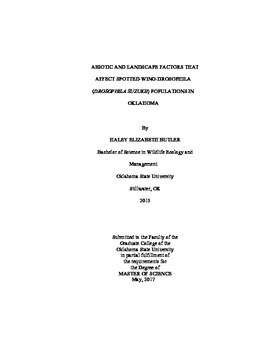| dc.contributor.advisor | Rebek, Eric | |
| dc.contributor.author | Butler, Haley Elizabeth | |
| dc.date.accessioned | 2018-06-08T19:57:53Z | |
| dc.date.available | 2018-06-08T19:57:53Z | |
| dc.date.issued | 2017-05-01 | |
| dc.identifier.uri | https://hdl.handle.net/11244/300018 | |
| dc.description.abstract | Spotted wing drosophila (SWD), Drosophila suzukii, is a species of fruit fly native to East Asia that has become a serious invasive pest around the world. SWD females possess a large sclerotized ovipositor that can puncture ripe or ripening fruit, on which eggs are laid, resulting in significant damage. SWD was first detected in the continental U.S. in 2008 in California and has since spread to almost every state. Crop damage caused by SWD in the western U.S. alone is estimated to be nearly $500 million annually (Cuthbertson et al. 2014). SWD is thus considered a serious economic threat to U.S. fruit production and research into SWD ecology and life history is needed to improve population management. In 2013, SWD was first recorded in Oklahoma in Tulsa County, threatening the state’s soft-fruit production (Lee 2014). SWD population monitoring was conducted using deli cup traps during the 2015 and 2016 blackberry growing season to determine population trends. Abiotic and biotic factors such as temperature, humidity, and habitat types were compared to SWD trap counts. To determine vegetation preference by SWD, traps were deployed in two different habitat types, tree lines or cropland, at each site. Our results showed that decreases in humidity negatively affect SWD populations and SWD occurs in higher numbers in tree lines than adjacent blackberry cropland. To determine alternative host plants of SWD, soft fruits from multiple plants were collected at the field sites, adult SWD allowed to emerged in the lab. Wild blackberry, pokeweed, and red mulberry were found to be hosts. SWD collected from deli traps in the field were also used for a separate genetic study using microsatellite markers to determine where Oklahoma populations originated from. The study determined multiple, genetically variable populations of SWD have been introduced into Oklahoma. The insight gained from this research will aid Oklahoma soft fruit producers in incorporating more effective tree line trapping and seasonal monitoring strategies into their integrated pest management plans to control SWD. | |
| dc.format | application/pdf | |
| dc.language | en_US | |
| dc.rights | Copyright is held by the author who has granted the Oklahoma State University Library the non-exclusive right to share this material in its institutional repository. Contact Digital Library Services at lib-dls@okstate.edu or 405-744-9161 for the permission policy on the use, reproduction or distribution of this material. | |
| dc.title | Abiotic and Landscape Factors that Affect Spotted-Wing-Drosophila (Drosophila suzukii) Populations in Oklahoma | |
| dc.contributor.committeeMember | Lee, Jackie | |
| dc.contributor.committeeMember | Royer, Tom | |
| osu.filename | Butler_okstate_0664M_15130.pdf | |
| osu.accesstype | Open Access | |
| dc.description.department | Entomology & Plant Pathology (MS) | |
| dc.type.genre | Thesis | |
| dc.type.material | text | |
